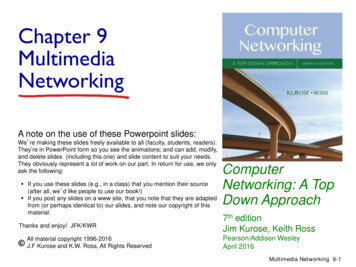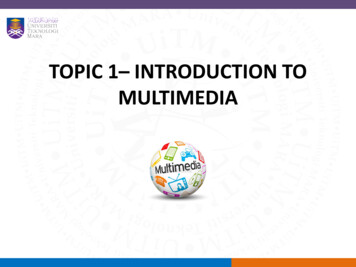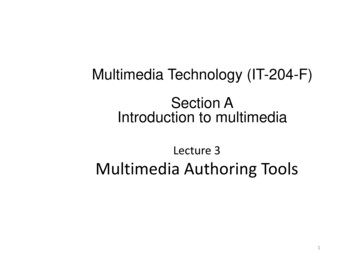
Transcription
Chapter 9MultimediaNetworkingA note on the use of these Powerpoint slides:We’re making these slides freely available to all (faculty, students, readers).They’re in PowerPoint form so you see the animations; and can add, modify,and delete slides (including this one) and slide content to suit your needs.They obviously represent a lot of work on our part. In return for use, we onlyask the following: If you use these slides (e.g., in a class) that you mention their source(after all, we’d like people to use our book!) If you post any slides on a www site, that you note that they are adaptedfrom (or perhaps identical to) our slides, and note our copyright of thismaterial.Thanks and enjoy! JFK/KWRAll material copyright 1996-2016J.F Kurose and K.W. Ross, All Rights ReservedComputerNetworking: A TopDown Approach7th editionJim Kurose, Keith RossPearson/Addison WesleyApril 2016Multimedia Networking 9-1
Multimedia networking: outline9.1 multimedia networking applications9.2 streaming stored video9.3 voice-over-IP9.4 protocols for real-time conversationalapplications9.5 network support for multimediaMultimedia Networking 9-2
Multimedia: audioquantizationerroraudio signal amplitude analog audio signalsampled at constant rate telephone: 8,000samples/sec CD music: 44,100samples/sec each sample quantized, i.e.,rounded e.g., 28 256 possiblequantized values each quantized valuerepresented by bits,e.g., 8 bits for 256valuesquantizedvalue ofanalog valueanalogsignaltimesampling rate(N sample/sec)Multimedia Networking 9-3
Multimedia: audioexample rates CD: 1.411 Mbps MP3: 96, 128, 160 kbps Internet telephony: 5.3 kbpsand upquantizationerroraudio signal amplitude example: 8,000 samples/sec,256 quantized values: 64,000bps receiver converts bits back toanalog signal: some quality reductionquantizedvalue ofanalog valueanalogsignaltimesampling rate(N sample/sec)Multimedia Networking 9-4
Multimedia: video video: sequence of imagesdisplayed at constant rate e.g., 24 images/sec digital image: array of pixels each pixel representedby bits coding: use redundancywithin and between imagesto decrease # bits used toencode image spatial (within image) temporal (from oneimage to next)spatial coding example: insteadof sending N values of samecolor (all purple), send only twovalues: color value (purple) andnumber of repeated values (N) . . frame itemporal coding example:instead of sendingcomplete frame at i 1,send only differences fromframe iframe i 1Multimedia Networking 9-5
Multimedia: video CBR: (constant bit rate):video encoding rate fixed VBR: (variable bit rate):video encoding rate changesas amount of spatial,temporal coding changes examples: MPEG 1 (CD-ROM) 1.5Mbps MPEG2 (DVD) 3-6 Mbps MPEG4 (often used inInternet, 1 Mbps)spatial coding example: insteadof sending N values of samecolor (all purple), send only twovalues: color value (purple) andnumber of repeated values (N) . . frame itemporal coding example:instead of sendingcomplete frame at i 1,send only differences fromframe iframe i 1Multimedia Networking 9-6
Multimedia networking: 3 application types streaming, stored audio, video streaming: can begin playout before downloading entirefile stored (at server): can transmit faster than audio/videowill be rendered (implies storing/buffering at client) e.g., YouTube, Netflix, Hulu conversational voice/video over IP interactive nature of human-to-human conversationlimits delay tolerance e.g., Skype streaming live audio, video e.g., live sporting event (futbol)Multimedia Networking 9-7
Multimedia networking: outline9.1 multimedia networking applications9.2 streaming stored video9.3 voice-over-IP9.4 protocols for real-time conversationalapplications9.5 network support for multimediaMultimedia Networking 9-8
Streaming stored video:1. videorecorded(e.g., 30frames/sec)2. videosentnetwork delay(fixed in thisexample)3. video received,played out at client(30 frames/sec) timestreaming: at this time, clientplaying out early part of video,while server still sending laterpart of videoMultimedia Networking 9-9
Streaming stored video: challenges continuous playout constraint: once client playoutbegins, playback must match original timing but network delays are variable (jitter), sowill need client-side buffer to match playoutrequirements other challenges: client interactivity: pause, fast-forward, rewind,jump through video video packets may be lost, retransmittedMultimedia Networking 9-10
Streaming stored video: revisitedclient videoreceptionvariablenetworkdelayconstant bitrate videoplayout at clientbufferedvideoconstant bitrate videotransmissiontimeclient playoutdelay client-side buffering and playout delay: compensatefor network-added delay, delay jitterMultimedia Networking 9-11
Client-side buffering, playoutbuffer fill level,Q(t)playout rate,e.g., CBR rvariable fillrate, x(t)video serverclient applicationbuffer, size BclientMultimedia Networking 9-12
Client-side buffering, playoutbuffer fill level,Q(t)playout rate,e.g., CBR rvariable fillrate, x(t)video serverclient applicationbuffer, size Bclient1. Initial fill of buffer until playout begins at tp2. playout begins at tp,3. buffer fill level varies over time as fill rate x(t) variesand playout rate r is constantMultimedia Networking 9-13
Client-side buffering, playoutbuffer fill level,Q(t)playout rate,e.g., CBR rvariable fillrate, x(t)video serverclient applicationbuffer, size Bplayout buffering: average fill rate (x), playout rate (r): x r: buffer eventually empties (causing freezing of videoplayout until buffer again fills) x r: buffer will not empty, provided initial playout delay islarge enough to absorb variability in x(t) initial playout delay tradeoff: buffer starvation less likelywith larger delay, but larger delay until user beginswatchingMultimedia Networking 9-14
Streaming multimedia: UDP server sends at rate appropriate for client often: send rate encoding rate constantrate transmission rate can be oblivious tocongestion levels short playout delay (2-5 seconds) to removenetwork jitter error recovery: application-level, time permitting RTP [RFC 2326]: multimedia payload types UDP may not go through firewallsMultimedia Networking 9-15
Streaming multimedia: HTTP multimedia file retrieved via HTTP GET send at maximum possible rate under TCPvariablerate, x(t)videofileTCP sendbufferserverTCP receivebufferapplicationplayout bufferclient fill rate fluctuates due to TCP congestion control,retransmissions (in-order delivery) larger playout delay: smooth TCP delivery rate HTTP/TCP passes more easily through firewallsMultimedia Networking 9-16
Multimedia networking: outline9.1 multimedia networking applications9.2 streaming stored video9.3 voice-over-IP9.4 protocols for real-time conversationalapplications9.5 network support for multimediaMultimedia Networking 9-17
Voice-over-IP (VoIP) VoIP end-end-delay requirement: needed to maintain“conversational” aspect higher delays noticeable, impair interactivity 150 msec: good 400 msec badincludes application-level (packetization, playout),network delays session initialization: how does callee advertise IPaddress, port number, encoding algorithms? value-added services: call forwarding, screening,recording emergency services: 911Multimedia Networking 9-18
VoIP characteristics speaker’s audio: alternating talk spurts, silentperiods. 64 kbps during talk spurt pkts generated only during talk spurts 20 msec chunks at 8 Kbytes/sec: 160 bytes of data application-layer header added to each chunk chunk header encapsulated into UDP or TCPsegment application sends segment into socket every 20msec during talkspurtMultimedia Networking 9-19
VoIP: packet loss, delay network loss: IP datagram lost due to networkcongestion (router buffer overflow) delay loss: IP datagram arrives too late for playoutat receiver delays: processing, queueing in network; end-system(sender, receiver) delays typical maximum tolerable delay: 400 ms loss tolerance: depending on voice encoding, lossconcealment, packet loss rates between 1% and10% can be toleratedMultimedia Networking 9-20
Delay onstant bitrate playoutat clientbuffereddataconstant bitratetransmissiontimeclient playoutdelay end-to-end delays of two consecutive packets:difference can be more or less than 20 msec(transmission time difference)Multimedia Networking 9-21
VoIP: fixed playout delay receiver attempts to playout each chunk exactly qmsecs after chunk was generated. chunk has time stamp t: play out chunk at t q chunk arrives after t q: data arrives too latefor playout: data “lost” tradeoff in choosing q: large q: less packet loss small q: better interactive experienceMultimedia Networking 9-22
VoIP: fixed playout delay sender generates packets every 20 msec during talk spurt.first packet received at time rfirst playout schedule: begins at psecond playout schedule: begins at out schedulep' - rplayout schedulep-rtimerpp'Multimedia Networking 9-23
Adaptive playout delay (1) goal: low playout delay, low late loss rate approach: adaptive playout delay adjustment: estimate network delay, adjust playout delay atbeginning of each talk spurt silent periods compressed and elongated chunks still played out every 20 msec during talk spurt adaptively estimate packet delay: (EWMA exponentially weighted moving average, recall TCP RTTestimate):di (1 α)di-1 α (ri – ti)delay estimateafter ith packetsmall constant,e.g. 0.1time received - time sent(timestamp)measured delay of ith packetMultimedia Networking 9-24
Adaptive playout delay (2) also useful to estimate average deviation of delay, vi :vi (1 β)vi-1 β ri – ti – di estimates di, vi calculated for every receivedpacket, but used only at start of talk spurt for first packet in talk spurt, playout time is:playout-timei ti di Kvi remaining packets in talkspurt are played outperiodicallyMultimedia Networking 9-25
Adaptive playout delay (3)Q: How does receiver determine whether packet isfirst in a talkspurt? if no loss, receiver looks at successive timestamps difference of successive stamps 20 msec -- talk spurtbegins. with loss possible, receiver must look at both timestamps and sequence numbers difference of successive stamps 20 msec and sequencenumbers without gaps -- talk spurt begins.Multimedia Networking 9-26
VoiP: recovery from packet loss (1)Challenge: recover from packet loss given smalltolerable delay between original transmission andplayout each ACK/NAK takes one RTT alternative: Forward Error Correction (FEC) send enough bits to allow recovery withoutretransmission (recall two-dimensional parity in Ch. 5)simple FEC for every group of n chunks, create redundant chunk byexclusive OR-ing n original chunks send n 1 chunks, increasing bandwidth by factor 1/n can reconstruct original n chunks if at most one lost chunkfrom n 1 chunks, with playout delayMultimedia Networking 9-27
VoiP: recovery from packet loss (2)another FEC scheme: “piggyback lowerquality stream” send lower resolutionaudio stream asredundant information e.g., nominalstream PCM at 64 kbpsand redundant streamGSM at 13 kbps non-consecutive loss: receiver can conceal loss generalization: can also append (n-1)st and (n-2)nd low-bit ratechunkMultimedia Networking 9-28
VoiP: recovery from packet loss (3)interleaving to conceal loss: audio chunks divided intosmaller units, e.g. four 5msec units per 20 msecaudio chunk packet contains small unitsfrom different chunks if packet lost, still have mostof every original chunk no redundancy overhead,but increases playout delayMultimedia Networking 9-29
Voice-over-IP: Skype proprietary applicationlayer protocol (inferredvia reverse engineering) encrypted msgs P2P components: clients: Skype peersconnect directly toeach other for VoIP callSkype clients (SC)Skypelogin serversupernode (SN)supernodeoverlaynetwork super nodes (SN):Skype peers withspecial functions overlay network: amongSNs to locate SCs login serverMultimedia Networking 9-30
P2P voice-over-IP: SkypeSkype client operation:1. joins Skype network bycontacting SN (IP addresscached) using TCP2. logs-in (username,password) to centralizedSkype login server3. obtains IP address forcallee from SN, SNoverlay or client buddy list4. initiate call directly tocalleeSkypelogin serverMultimedia Networking 9-31
Skype: peers as relays problem: both Alice, Bobare behind “NATs” NAT prevents outside peerfrom initiating connection toinsider peer inside peer can initiateconnection to outside relay solution:Alice, Bobmaintain open connectionto their SNs Alice signals her SN to connectto BobAlice’s SN connects to Bob’sSNBob’s SN connects to Bob overopen connection Bob initiallyinitiated to his SNMultimedia Networking 9-32
9.3 voice-over-IP. 9.4 protocols for . real-time . conversational applications. 9.5 network support for multimedia. Multimedia Networking. 9-2. . generalization: can also append (n-1)st and (n-2)nd low-bit rate chunk. VoiP: recovery from packet loss (2) Multimedia Networking. 9-28. interleaving to conceal loss: audio chunks divided into .










